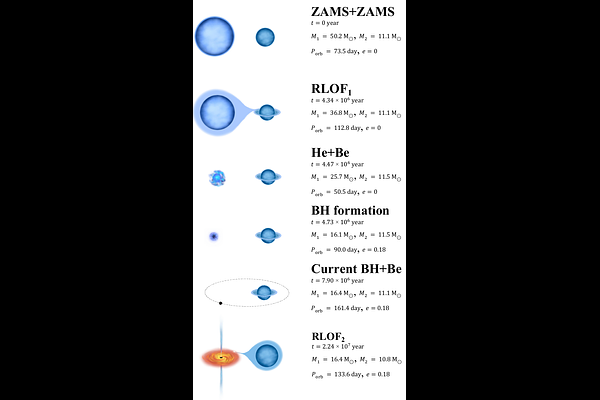A Be star-black hole binary with a wide orbit from LAMOST time-domain survey

A Be star-black hole binary with a wide orbit from LAMOST time-domain survey
Qian-Yu An, Yang Huang, Wei-Min Gu, Yong Shao, Zhi-Xiang Zhang, Tuan Yi, B. D. Lailey, T. A. A. Sigut, Kyle Akira Rocha, Meng Sun, Seth Gossage, Shi-Jie Gao, Shan-Shan Weng, Song Wang, Bowen Zhang, Xinlin Zhao, Senyu Qi, Shilong Liao, Jianghui Ji, Junfeng Wang, Jianfeng Wu, Mouyuan Sun, Xiang-Dong Li, Jifeng Liu
AbstractBinary systems consisting of an early type star and a black hole (BH) are crucial for understanding various astrophysical phenomena, particularly the origins of detected gravitational wave sources. Be binary systems are expected to represent a key evolutionary stage in hosting BHs. However, while hundreds of Be X-ray binaries are known, the only confirmed BH candidate in a Be binary remains highly controversial. We report the discovery of ALS 8814, a Be star-BH binary with a moderately eccentric ($e = 0.23$) and wide orbit ($P = 176.6$ days), revealed by the radial velocity (RV) measurement of the visible Be star. Our analysis, combining flux-calibrated spectra in the Balmer discontinuity region and spectral template matching, yields a mass of $11.2^{+1.4}_{-1.2}$ $M_\odot$ for the Be star. The minimum mass of the unseen companion, assuming an edge-on inclination ($i = 90^{\circ}$), is $9.8\pm 0.7\,M_\odot$. We rule out the presence of non-degenerate companions in ALS 8814, indicating that it can only be a BH. This discovery represents a robust case of a Be-BH binary, identified purely through precise RV measurements from a single set of lines. The extremely low peculiar velocity of ALS 8814 suggests that the BH is formed via a direct core-collapse with a negligible natal kick, implying an almost perfect alignment between the Be star's spin and the orbital plane. In this context, the binary's inclination angle is estimated to be 22$^{\circ}$-49$^{\circ}$ by analyzing the shallow double-peaked profile of the H$\alpha$ emission line. This inclination range corresponds to a BH mass estimate between $15\,M_\odot$ and $58\,M_\odot$. As the only unambiguous Be-BH binary system known to date, ALS 8814 provides valuable constraints on the BH formation in a binary system with a high-mass companion.